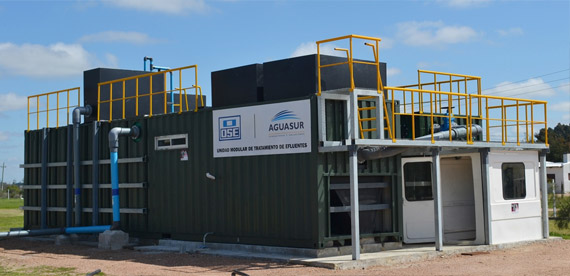The Modular Effluent Treatment Units (UMTE) are treatment plants placed inside standard-sized containers which, through biological processes, such as the activated sludge process, extended aeration and subsequent chlorination, remove contaminants and disinfect wastewater.
They alternate between continuous-flow and batch operation.
One characteristic feature of these units is the use of sand as support material.
They are manufactured with plastic engineering materials, and their innovative design utilizes the whole surface of the reactors, thus increasing aeration time and, therefore, efficiency.
The plants are modular, scalable and portable.
They are characterized by the reduction of organic matter they perform and by their high-efficiency in wastewater N & P (nitrogen and phosphate) removal to any quality standard required.

Compliance with increasingly prevalent environmental standards and the need for fast infrastructure solutions for sanitary emergencies require practical, module-based, easy-to-implement, portable, and cost-effective wastewater treatment solutions, capable of adapting to a variety of situations.
The wastewater treatment plant uses an activated sludge biological process with lamella sedimentation and subsequent disinfection with sodium hypochlorite, producing high-quality effluent stream, in compliance with the strictest environmental standards. Waste sludge is sent to a UMTE external system for further treatment consisting of thickening and dehydration before its final disposal.
The modular structure of the plant comprises a serial connection of treatment units combined with parallel connection of solid separation units, which leverages the advantages of each system. Wastewater biological treatment is performed through complete-mix, cascade-technique processes.
In terms of escalation, the treatment process is performed in so-called basic units, which comprise all the processes required for the thorough treatment of water. The number of units is suited to the size of the population served. Consequently, by connecting several basic units, the coverage of the population served is increased.
The containers are ordinary, easy to transport, shipping containers. Inner compartments (reactors and sedimentation tanks) are made of high-density polyethylene (HDPE).

© 2024 CUPH ROCCO SA - Web: D11